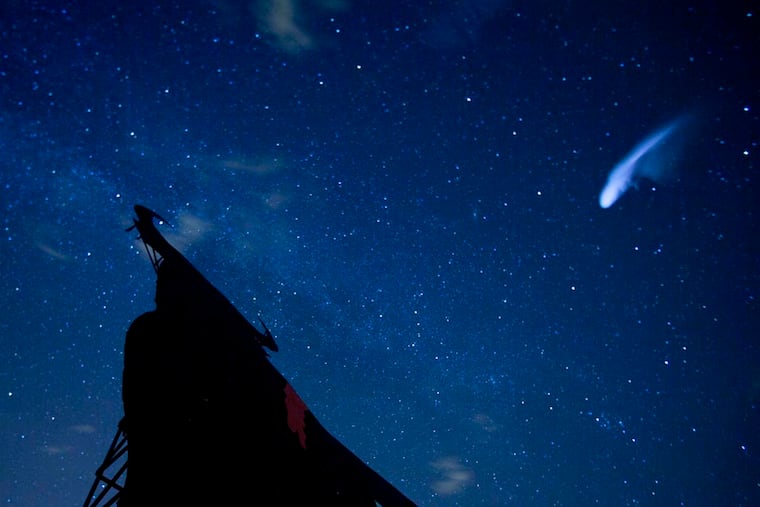Geminid meteor shower, the best of the year, is about to peak
Skies permitting, as many as 150 meteors an hour would be visible at the peak.

One of the cosmic developments of the 21st century will be evident the next few nights, reaching a climax in the very early morning hours of Monday with the peak of the annual Geminid meteor shower, the most productive of the year.
Sometime in the 21st century, it is not clear exactly when, the upstart Geminids supplanted the venerable Perseids of August as the king of the annual meteor shows visible around Philadelphia, said William J. Cooke, chief of NASA’s Meteoroid Environment Office.
As many as 150 meteors an hour, with intermittent fireballs possible, could be visible around the peak, which would be centered near 2 a.m. Monday, he said. About half that number would fill the sky on the preceding and succeeding nights, but that would rival or exceed the peak of the Perseids.
NASA will be live-streaming the meteor show start at 9 p.m. EST Sunday into early Monday.
“We expect every weekend night to produce a good display,” says EarthSky.org. Unfortunately the sky-cover forecasts aren’t promising, and Monday night into Tuesday morning might be the best bet based on the outlooks.
The Geminid shower is unusual, possibly unique, in that its source is a rather pipsqueak-ish asteroid, 3200 Phaeton, rather than a disintegrating comet.
The Geminid is “the biggest of the year,” Cooke said, “and it’s a young shower.” Young in this case would be a relative concept. Phaeton is “billions” of years old, but it wasn’t discovered until 1983, 111 years after the Geminid shower itself was first observed.
By contrast, comet observer Gary W. Kronk documented sightings of the Perseids in Chinese annals dating to AD 36, according to the American Meteor Society.
For viewers, one advantage the Perseids have over the Geminids is that August nights tend to be warmer than December’s.
That said, veteran skywatchers hold that the Geminids are worth the privation at a time when the moon will be taking a pre-Christmas break.
About the Geminids
Those meteors actually are the fallout of a molting, speeding asteroid that appears to be leaving behind more material every year.
In mid-December annually the Earth’s orbit intercepts its debris cloud. The particles enter the atmosphere at 78,000 mph and become incandescent, and few of them ever make to the surface.
The Geminids were no great shakes when they first were identified, said NASA’s Cooke, and at least for most of the 20th century were second bananas to the storied Perseids.
However, Phaeton has been shedding ever more material, and debris trail has become more impressive. The Geminds now exceed the Perseids in both quantity and flair, Cooke said.
“They are rich in fireballs,” he said.
How, when, and where to look
If you want your fireballs, you’ll have to start with a dash of patience, Cooke advises. Ideally, you’ll want to spend 45 minutes outside adjusting to the darkness. But both EarthSky and Dwight Dulsky of the Bucks-Mont Astronomical Association say 20 minutes would do.
» READ MORE: Stargazing around Philadelphia: Everything you need to know
Don’t, don’t look at your iPhone, Cooke said. Even a glance at the screen could undue all your eyes’ hard-earned darkness adjustments.
The best moment would be centered on 2 a.m. Monday. Look directly overhead, where the constellation Gemini would be. Showers are named for the constellations from which they radiate, “but the meteors you see may be several minutes apart and appear in different parts of the sky,” said Dulsky.
You should plan on investing an hour or two to get the full effects, and be aware that meteors often come in spurts, followed by lulls.
Unfortunately, due to COVID-19 restrictions, this is not the year for meteor-watching parties, and most state parks, such as French Creek, a popular dark spot, close at sunset.
But anywhere you can find a meadow or clearing away from city lights would provide good viewing. The key, says Cooke, is to get as far from the lights as possible.
“You should not observe alone,” Dulsky advises. “Plus it’s more fun to share a meteor shower with a friend or two.”